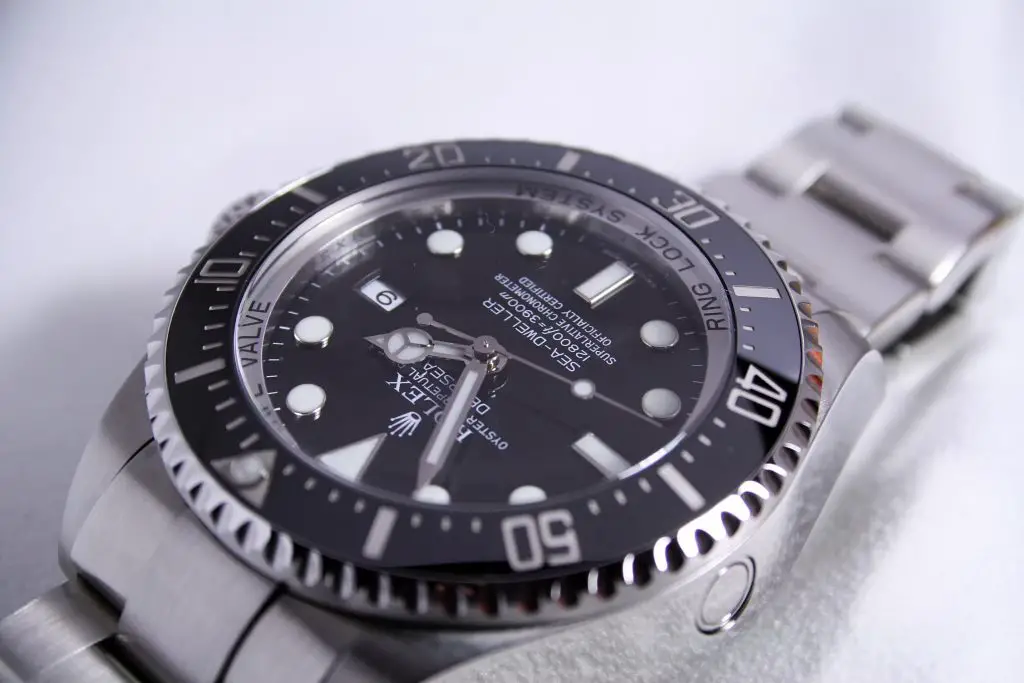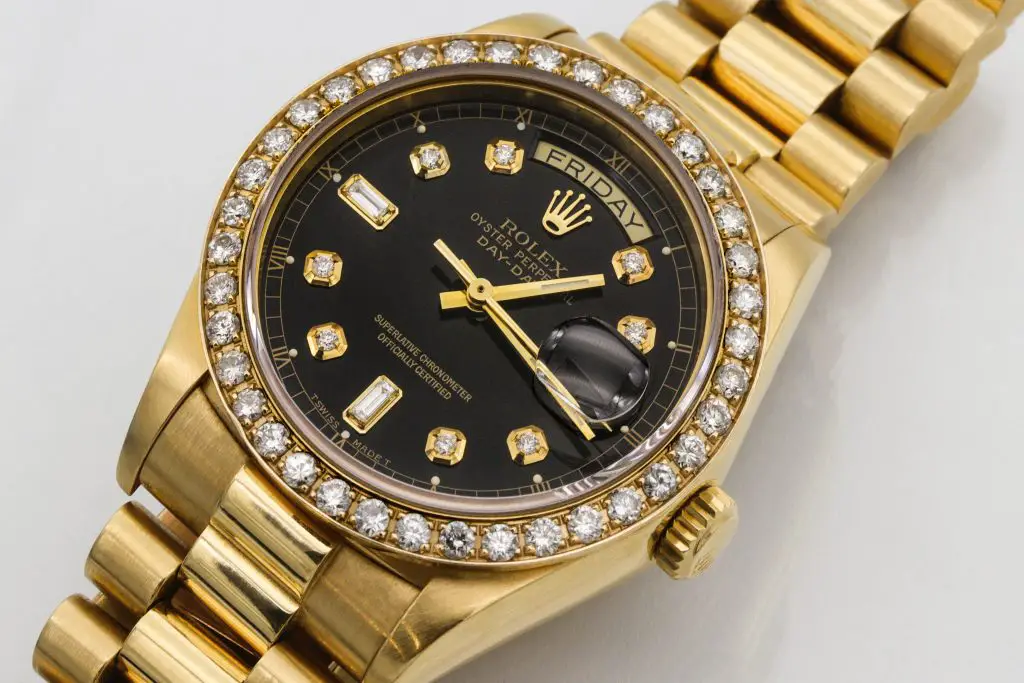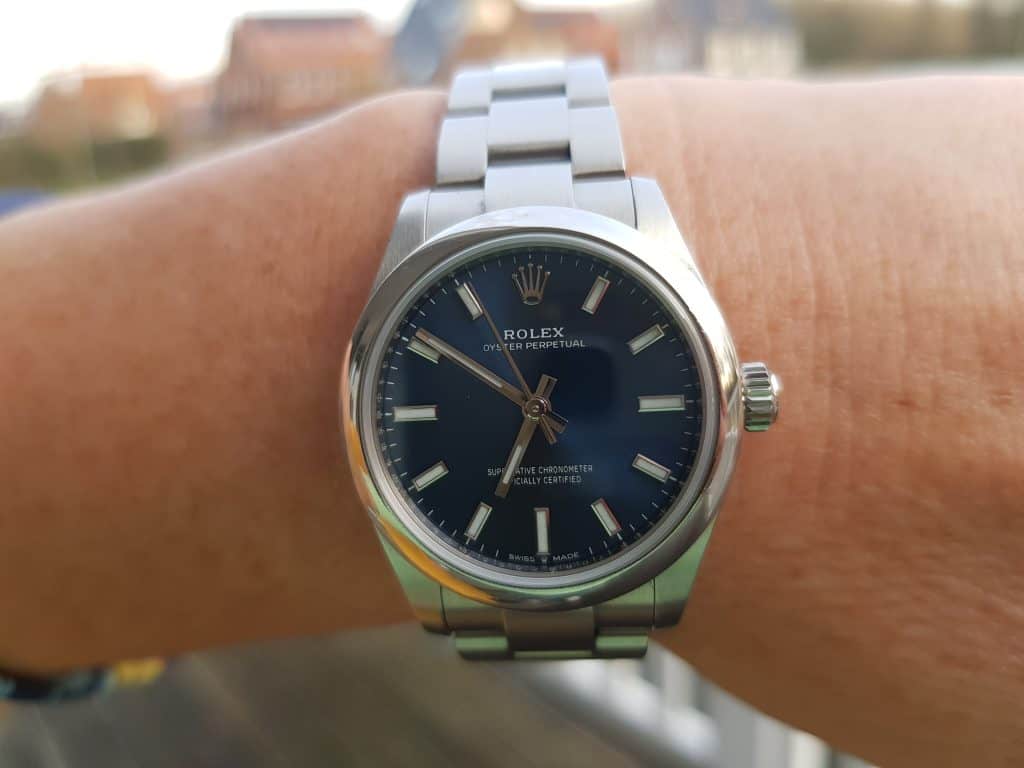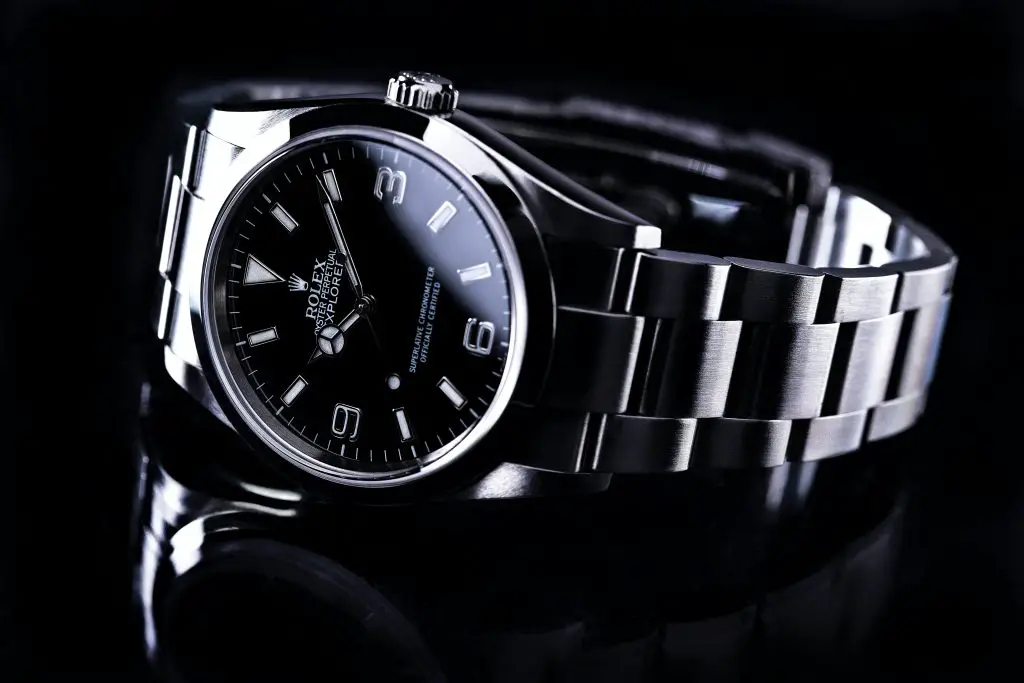Many watches have a ticking sound that you can clearly hear when you listen closely. But do Rolex watches tick as well?
A Rolex watch does not make a ticking sound. The gears in a Rolex watch are so expertly crafted and placed that it creates a fluid and soundless motion. If a Rolex watch does tick, it’s a clear indicator of it being a counterfeit watch.
A ticking Rolex is most likely a fake one; however, there are actually a few very rare and old models of Rolex that can make a ticking sound. In this article, we’ll dive deeper into the question; do Rolex watches tick?

Table of Contents
Do Rolex Watches Tick?
When we talk about watches ‘ticking’, we can interpret that in two ways:
- A ticking sound.
- A ticking motion (movement) of the second hand.
Before diving in, it’s important to note that both the ticking sound and ticking motion come from the second hand. This watch part is responsible for practically everything ‘ticking’ related.
Let’s now take a look at both of these interpretations and see how Rolex watches fare.
Do Rolex Watches Make A Ticking Sound?
The general rule is that a Rolex watch does not tick. At least, not to the extent that we would hear it clearly.
Like any watch, the movement of the gears inside is not entirely silent, but it’s safe to say that Rolex watches are one of, if not the most silent.
Watches that make a ticking sound tend to be quartz watches, and Rolex, bar 2 models, only make mechanical timepieces.
We’ll go more in-depth on why quartz watches make a ticking sound later on, but the gist of it is that quartz watches function on a battery. The battery sends out an electric shock, which makes the gears move. Since an electric shock isn’t the most gentle way to get things moving, the gears make a ticking sound when they are shocked.
As mentioned earlier, Rolex makes mechanical watches, which function on a higher frequency (more on that later!).
With that being said, if you listen really closely, you might be able to hear some movement. These are the gears moving along, and you can hear a soft ticking sound.
But you’ll need to be in a completely silent room and press the watch against your ear if you want to hear this. It’s that quiet.

Do Rolex Watches Have A Ticking Or Sweeping Second Hand
Another way to look at the ‘tick’ of a watch is by looking at how the second hand moves. This hand shows you what second we’re in, and there are two ways this hand typically moves.
It either ticks forward, jumping from second to second, or it sweeps, almost glides smoothly onto the next second.
Rolex watches always have that smooth gliding motion instead of the rougher ticking motion. And this mainly has to do with the movement itself.
Going back to quartz watches, they function on a battery, which sends an electric shock that makes the hands move. Quartz watches always tick forward as they function on a lower frequency.
Mechanical watches function on the energy stored in the mainspring and have a higher frequency. This allows the second hand of mechanical watches to glide smoothly instead of jump forward.
Since Rolex only makes mechanical watches (with the exception of 2 models), basically all Rolex watches will glide forward and not tick forward.
What Makes A Ticking Sound In A Watch
Most watches will have a ticking sound, whether extremely loud (as is the case with Timex watches) or relatively silent. But where does this ticking sound come from?
The ticking sound in a watch comes from the movement of the gears. This is especially prevalent in quartz watches, which are powered by a battery. Mechanical watches can also have a ticking sound but tend to be quieter.
Before diving into the ticking sound of a watch, we’ll first have to distinguish between a quartz watch and a mechanical watch because there’s a difference in the sound they make.
A quartz watch is a battery-powered watch. This battery will send a ‘shock’, which makes the gears move. This will result in a ticking sound and how the second hand will move. Most watches are quartz watches, and you’ll notice that the hand almost jumps over to the next second.
A mechanical watch gets its movement from the power stored in the mainspring. The mainspring receives its energy from being manually wound or from the movement of the rotor when the watch is worn. What this often leads to is a much smoother movement of the hand. It’s almost gliding to the next second.

Both types of watches will have a ticking sound, but the loudness of it will vary. Generally speaking, a quartz watch will have a louder ticking sound.
In a quartz watch, the gears inside will move via a battery. This battery periodically sends out a wave of energy that makes the gears move. When the gears are moving, the watch hands are moving with it.
Due to a quartz watch working with a battery, the gears move on a 1 Hz beat per second. This is a lot lower frequency when compared to mechanical watches, which move on a 4 Hz beat per second. Most times, though, this ticking sound isn’t annoyingly loud, but you can hear it in a quiet room.
For a mechanical watch, everything’s a bit different. Due to the gears inside moving via de energy stored in a mainspring, you’ll have a ‘smoother’ gear movement.
This smoother gear movement will, in turn, produce a more silent tick. Sometimes, the ticking sound won’t even be noticeable until you put your ear against the watch.
I had a hard time trying to identify that ticking sound in my Rolex Oyster Perpetual. I had to go to the quietest place in my house and really press the watch against my ear.
Both mechanical watches and quartz watches are commonly produced, and there isn’t really a ‘better’ version. It mainly comes down to personal preference.
That being said, Rolex is known for making mechanical watches with a highly silent tick. This leads people to believe that a Rolex watch should never tick.
This isn’t entirely true, though, as even mechanical watches will have a (very silent) ticking sound. And on top of that, Rolex has actually made a few quartz watches back in the day that do have a slightly louder tick.
The Rare Few; What Rolex Watches Do Tick
Factually, every Rolex ticks. However, we’re not looking for those near-silent Rolex watches. Instead, we’re looking for the rare few quartz watches made by Rolex.
In the 1970s, the Asian watch market was starting to get dominated by Japanese watch brands. Citizen, in particular, started to produce such massive quantities that Swiss watch brands began to slowly fade away. These Japanese watches were mainly quartz watches, and Rolex wanted a piece of the pie.
So, they brought their own line of quartz watches, the Rolex Oysterquartz line; Rolex Oysterquartz Datejust and Rolex Oysterquarts Day-Date.
These new watches from Rolex were quite different from their usual models. The case was completely angular, and the band was integrated, making for a new and unique Rolex watch.
Aside from the different looks and movements, the Oysterquartz collection was available in three different colors; gold, steel with white gold, and yellow gold.
As intended, this watch collection was very popular in Asia, but also in the United States. However, the true popularity of the Rolex Oysterquartzes came after Rolex decided to take them out of its catalog. No longer were these Rolex Oysterquartz watches made, which caused a surge in popularity and price.
Just like any quartz watch, this watch ticks. A Rolex watch that actually ticks and isn’t fake.
It’s a rare sight, but they do exist. You can still purchase them today via auctions, but be prepared to pay a lot of money, as this is a collector’s item.
Are Mechanical Rolex Watches Completely Silent?

As we mentioned above, even mechanical watches will make a sound. This sound can be extremely quiet, and sometimes it can even be challenging to hear, but there is a ticking sound present.
When you purchase a mechanical Rolex (which is every Rolex produced nowadays), you’ll have a hard time ever hearing that ticking sound. It’s already quite difficult to hear the ticking sounds from a Seiko quartz watch, let alone a mechanical Rolex watch, known for being one of the quietest timepieces.
We’re not sure how they do it, but the Rolex watchmakers make some of the quietest watch movements ever. Guess that’s the benefit of purchasing such a luxurious item.
And this doesn’t only go for their high-end models either. Every Rolex watch currently in production will be very quiet, from the more affordable Oyster Perpetuals to the more expensive Day-Dates.
Conclusion
Rolex specializes in making silent movements, and they are at a point where a loud ticking noise is the number one giveaway for a fake copy. Counterfeit watch producers simply cannot make such refined and smooth motions, so there’s always the presence of a noticeable ticking sound.
There are two Rolex models, the Rolex Oysterquartz Datejust and Day-Date, that have a more distinct ticking sound. These are the only Rolex watches that utilize a quartz movement, which typically comes with a slightly louder tick and a second hand that jumps forward instead of gliding.
However, both Rolex Oysterquartz models are so rare that you probably won’t ever encounter them. So if you ever hear a Rolex watch tick, you’ll know that it’s most likely a fake.
